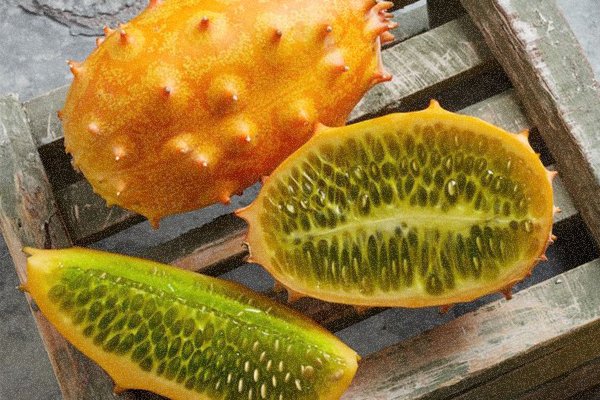Kiwano fruit
Everything you need to know about kiwano fruit 🥭 :)

🥭 Kiwano (lat. Cucumis metuliferus) is a plant from the Cucurbitaceae family.
It originates from Africa, and it is also called kiwano fruit, African melon and horned melon, because its bark is covered with small thorns 🤓 It tastes similar to a mixture of melon and pineapple, and looks like a cucumber.
Inside, the gelatinous texture is filled with seeds that are rich in fatty acids, including linoleic and oleic, which are essential for human health.
Kiwano is rich in vitamins C, B and E, magnesium, iron, calcium, potassium, manganese and phosphorus 💪
Kiwano is used at all stages of growth 🤩 While it tastes green, it is similar to cucumber, only when it ripens, which is visible on the peel, which becomes yellow-orange, it becomes sweet and reminiscent of a mixture of melon and pineapple.
Kiwano fruit 🥭
Used as a refreshing drink or fresh fruit. It is excellent as an addition to green juices. It is also used as a decoration for desserts, cakes and salads. The easiest way to consume it is to cut it in half and use a spoon to dig out the pulp together with the seeds 🤗
Due to the large amount of vitamin C, it is excellent in the prevention of colds, and due to the antioxidants it contains, it has numerous positive effects on the health of the skin, heart, muscles, nerves and red blood cells.
How to grow kiwano
Kiwano is grown in the same way as cucumber 🥒 It is a tropical culture and sensitive to low temperatures. Seeds can be sown directly into the ground in late April or early May in houses in which several seeds are placed at a distance of about 30 cm, and between rows about 1 - 1.5 m, to a depth of 1 cm.
Another way of sowing is to sow in a line along the net with a distance of a few cm, seed from seed. It is good to add compost to houses or rows (depending on the type of sowing) and with regular watering kiwano really does not require any more care. Since kivano forms burrows, it is best to grow it on a net, so before sowing, it is necessary to make a construction and set a net for cucumbers, so that it can crawl freely. The most important thing for growing is to know that sour fruit grows similarly to a cucumber, so you can let it stretch around the garden, or make some ladders to climb.
When a small fruit first appears, it is green in color, and full of thorns. The young fruit has a leaf-like color, so it may surprise you as you untangle the vine.
Each branch can produce about 100 fruits. As the fruit grows and ripens, it changes color from green to white, yellow and eventually turns orange.
Horned melons are best suited to clay and loam, pH values from 6.0 to 6.5. Water slowly and deeply, in the morning or afternoon.
Flower and fruit of kiwano
Kiwano forms a fruit in the lower parts. The first fruits begin to grow in August. As they grow quickly, they begin to ripen at the beginning of September, while others are just beginning their growth phase, so the harvest will be until the first frost, and after that it is necessary to harvest all the fruits that will ripen later.
NOTE
If the fruit is not ripe, it has a bitter taste and a dangerous dose of chemicals that are not present when the fruit is ready to eat. This toxicity can cause stomach problems, headaches, fever, but it will not endanger your life 😉
